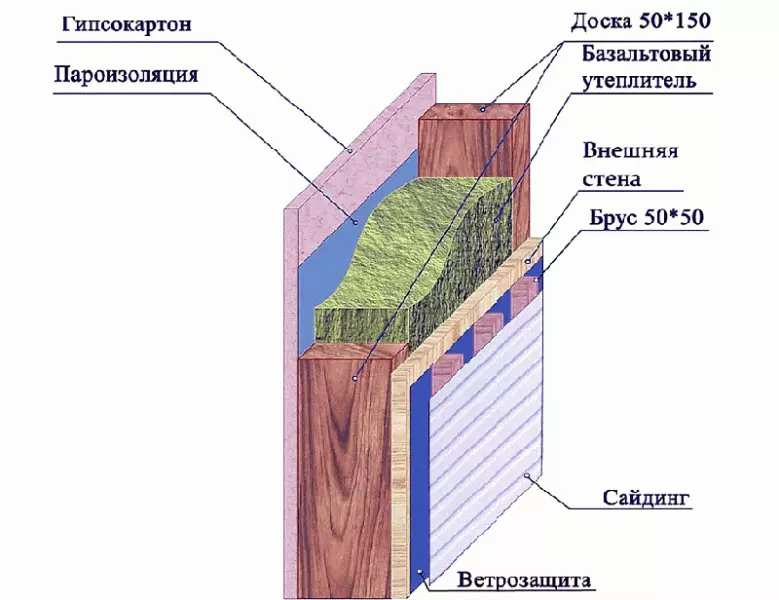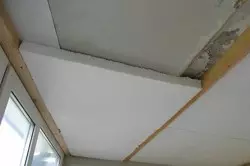Today, balconies and loggias are no longer used as storerooms, where everything of unnecessary trash is stored. Today, the balcony space is equipped as comfortable as possible and is considered as a recreation area or household sessions. In this regard, it is very important that the internal balcony space is protected from a variety of unpleasant influences from the outside, for example, from sedimentary moisture, refurbishment, flooding. In addition, it is necessary that the loggia is warm and cozy.

Materials for the insulation of the loggia are selected individually based on the financial capabilities and features of the loggia.
Such conditions are ensured, in particular, due to timely waterproofing and insulation of the balcony ceiling. To carry out these procedures in modern conditions is very simple, because today there are materials on sale, using which, you can, very quickly and simply provide insulation and waterproofing the ceiling on the balcony.
Materials used
In order for all work to be perfect, efficiently and reliably, it is necessary to choose the most suitable materials suitable for a particular situation. The following is proposed a standard list of materials for waterproofing and insulating work on loggia. Such a list may vary with regard to the complexity of the problem due to the presence, for example, large gaps, gaps between ceiling concrete slabs, etc. So, it is advisable to use the following set of materials:- sealant (silicone, acrylic, bituminous, polyurethane) for embedding cracks;
Such sealants are very convenient to use and reliable. Of course, the cracks can be laid down, and fill the installation foam, but it is more convenient and most reliable to apply precisely sealants.
Especially since they do not need a lot due to the fact that the area of the balcony and the ceiling is not so great;
- The penetrating composition for the waterproofing of concrete is a reliable way to make a ceiling slab of the loggia by 100% waterproof. After applying such a composition, the waterproofing of the ceiling becomes as efficient as possible;
- Foloisolone is a material that will perform both the function of the additional waterproofing barrier and the insulation;
- The sheets of extruded polystyrene foam are excellent material for thermal insulation of small rooms. It is very simply attached to the ceiling and does not greatly reduce the space limited to the size of the balcony;
- Building glue, knife, scissors and other tools that can be useful for cutting and attaching the materials listed above. The sealant is applied using a special tube, in which it is sold.
Thus, you need a small set of materials and tools so that waterproofing on the loggia is made high quality and reliably. In addition, given the small area of the room, such materials need not so much, because of which the costs will be insignificant.
The process of working on insulation and waterproofing the ceiling on the loggia

The seating of the balcony with waterproofing will be reliably protected from the penetration of moisture and fluid from the outside, subject to the correct use of all materials.
The ceiling of the balcony, the waterproofing of which is carried out by the owners of the apartment, will be reliably protected from the penetration of moisture and fluid from the outside, subject to the correct use of all materials. The sequence of work may be as follows:
- In the presence of cracks, it is necessary to close them with an insulating material. It is more expedient to use building sealants sold in special tubes to perform this task. Using such a tuba, fill the cracks with a sealant and expect it to full frost. This composition reliably protects from the penetration of moisture through the slots in concrete slabs, between them, as well as between the ceiling plates and walls.
- The waterproofing of the balcony of the loggia will be as efficient as possible when using a special penetrating composition. It is important to use it correctly. It is best to apply this tool in spring or autumn, since when it dried it should not be cold or hot. After applying a solution of the penetrating waterproofing composition on the surface of the plate, it is necessary to provide a long (about 3 days) drying. If the slab will dry faster, it will need to be born with water. After a long drying, the penetrating composition will create an inside of the concrete slab such a crystal structure that will reliably protect the balcony ceiling from the flue for many decades.
- If in the future it is not supposed to use the additional insulation of the balcony, then as another level of waterproofing and a small insulating layer, you can use such an interesting material like a folgicone. Waterproofing with it will be brought to perfection, and its mounting to the ceiling can be carried out by any convenient ways: with glue, with mounting to a wooden frame or frame with a bracket, etc. It cuts the same hydroize organon with ordinary scissors.
- In the case of restrictions on waterproofing with sealants and penetrating material, it will be very convenient to glue the ceiling with a construction glue such a universal insulating material, such as sheets of extruded polystyrene foam. They are convenient because you can pick up different sheet thickness, cut any necessary shape and simply glue to the ceiling concrete plate. In addition, polystyrene foam sheets create a minimum of inconvenience subsequently when the facing ceiling material is installed.
Thus, modern materials used for waterproofing make it very simple, quickly and, at the same time, securely protect the balcony ceiling and all the balcony space from the penetration of moisture and from unwanted reference. Thanks to this, balconies and loggias turn into full-fledged residential spaces of modern apartments that can be used with different purposes.
Article on the topic: Washing in the country with your own hands: Required tools and materials
